The Role of Brand Loyalty in UK Sportswear Consumer Buying Behavior
VerifiedAdded on 2022/12/18
|68
|20071
|1
Thesis and Dissertation
AI Summary
This dissertation investigates the relationship between brand loyalty and consumer buying behavior within the UK sportswear industry, with a specific focus on consumers in the United Kingdom. The research aims to examine how brand loyalty influences purchasing decisions and explores the moderating effects of demographic factors such as gender, age, and income. The study employs a quantitative research design to analyze the influence of these variables. The dissertation includes an introduction outlining the research problem, objectives, and hypotheses, followed by a comprehensive literature review that examines brand loyalty, consumer buying behavior models, and the impact of demographic factors. The methodology section details the research approach, design, data collection methods, sampling techniques, and ethical considerations. The results section presents the findings of the data analysis, including reliability and validity analysis, descriptive statistics, and correlation and regression analyses. The discussion chapter interprets the results, and the conclusion summarizes the key findings, recommendations, and limitations of the study. The research seeks to provide valuable insights for sportswear companies to develop effective marketing strategies and enhance consumer loyalty.
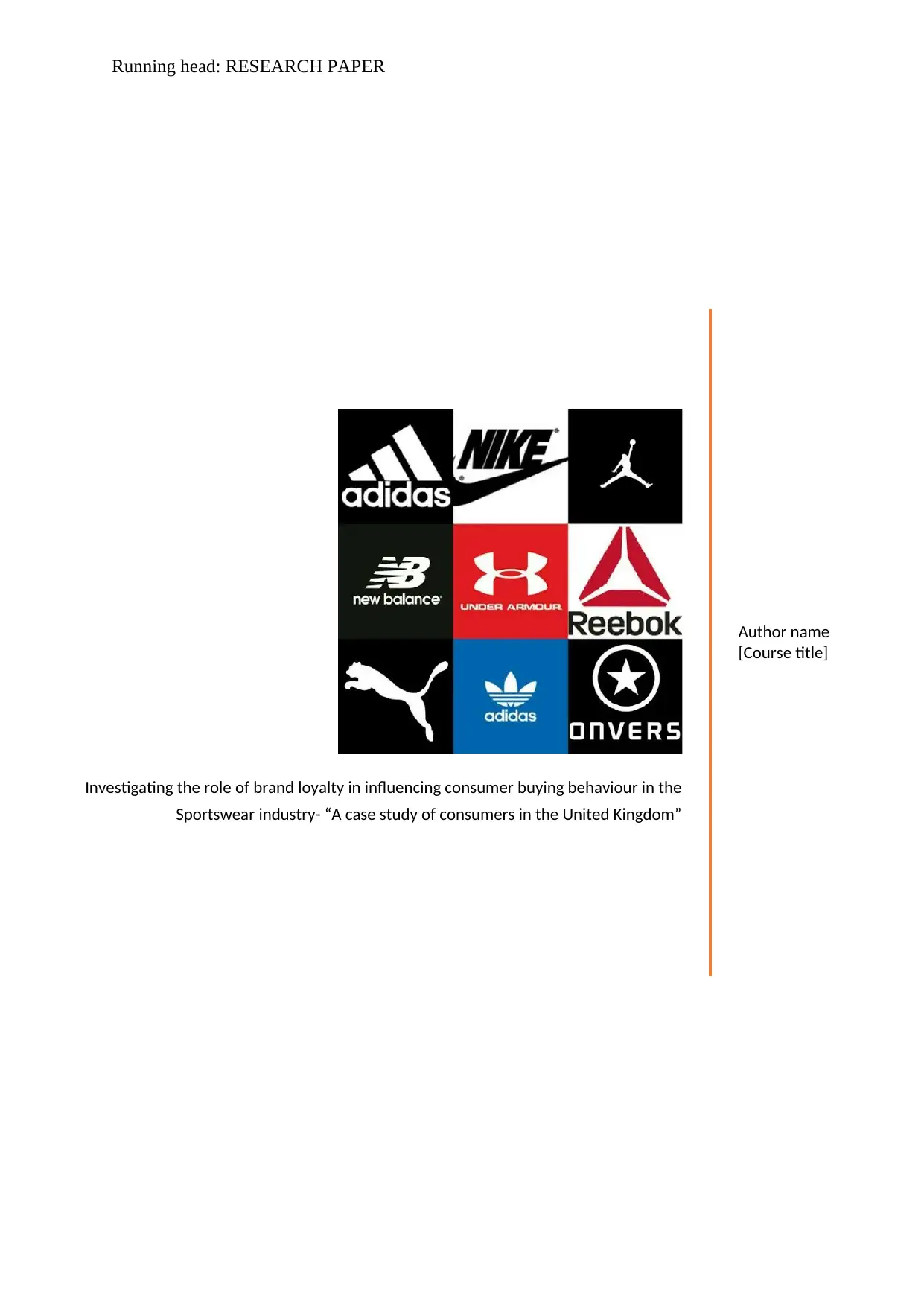
Running head: RESEARCH PAPER
Investigating the role of brand loyalty in influencing consumer buying behaviour in the
Sportswear industry- “A case study of consumers in the United Kingdom”
Author name
[Course title]
Investigating the role of brand loyalty in influencing consumer buying behaviour in the
Sportswear industry- “A case study of consumers in the United Kingdom”
Author name
[Course title]
Paraphrase This Document
Need a fresh take? Get an instant paraphrase of this document with our AI Paraphraser
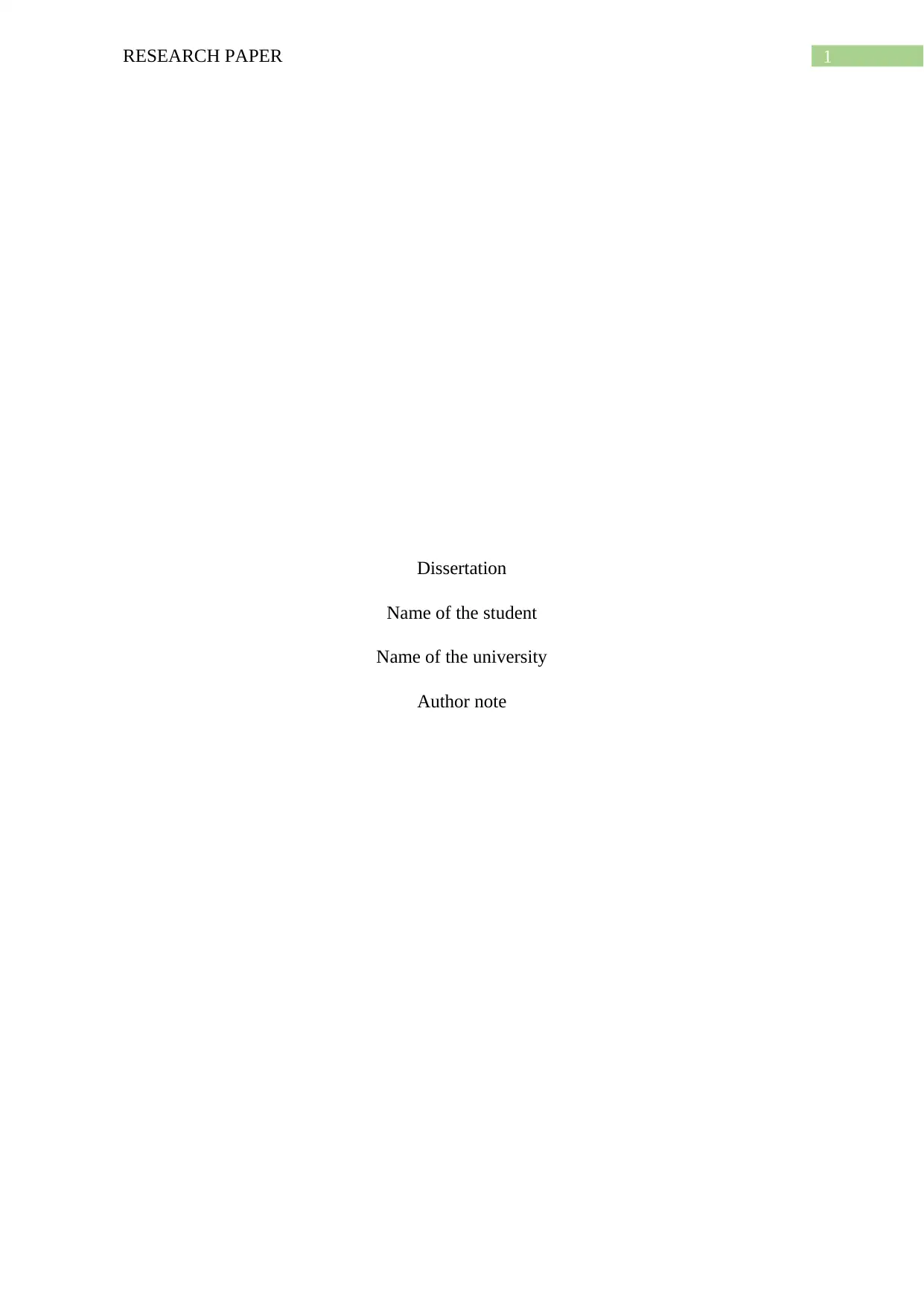
1RESEARCH PAPER
Dissertation
Name of the student
Name of the university
Author note
Dissertation
Name of the student
Name of the university
Author note
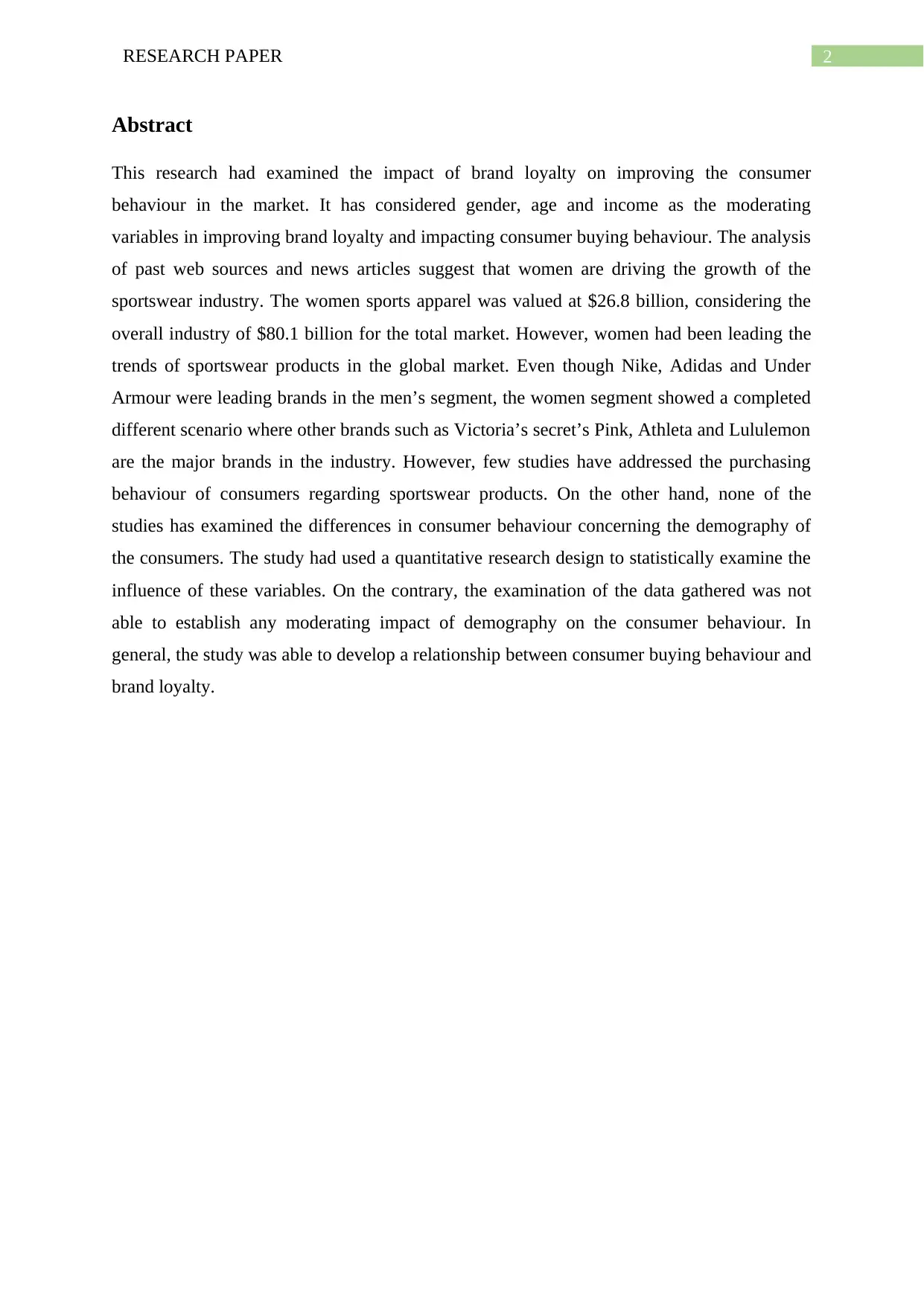
2RESEARCH PAPER
Abstract
This research had examined the impact of brand loyalty on improving the consumer
behaviour in the market. It has considered gender, age and income as the moderating
variables in improving brand loyalty and impacting consumer buying behaviour. The analysis
of past web sources and news articles suggest that women are driving the growth of the
sportswear industry. The women sports apparel was valued at $26.8 billion, considering the
overall industry of $80.1 billion for the total market. However, women had been leading the
trends of sportswear products in the global market. Even though Nike, Adidas and Under
Armour were leading brands in the men’s segment, the women segment showed a completed
different scenario where other brands such as Victoria’s secret’s Pink, Athleta and Lululemon
are the major brands in the industry. However, few studies have addressed the purchasing
behaviour of consumers regarding sportswear products. On the other hand, none of the
studies has examined the differences in consumer behaviour concerning the demography of
the consumers. The study had used a quantitative research design to statistically examine the
influence of these variables. On the contrary, the examination of the data gathered was not
able to establish any moderating impact of demography on the consumer behaviour. In
general, the study was able to develop a relationship between consumer buying behaviour and
brand loyalty.
Abstract
This research had examined the impact of brand loyalty on improving the consumer
behaviour in the market. It has considered gender, age and income as the moderating
variables in improving brand loyalty and impacting consumer buying behaviour. The analysis
of past web sources and news articles suggest that women are driving the growth of the
sportswear industry. The women sports apparel was valued at $26.8 billion, considering the
overall industry of $80.1 billion for the total market. However, women had been leading the
trends of sportswear products in the global market. Even though Nike, Adidas and Under
Armour were leading brands in the men’s segment, the women segment showed a completed
different scenario where other brands such as Victoria’s secret’s Pink, Athleta and Lululemon
are the major brands in the industry. However, few studies have addressed the purchasing
behaviour of consumers regarding sportswear products. On the other hand, none of the
studies has examined the differences in consumer behaviour concerning the demography of
the consumers. The study had used a quantitative research design to statistically examine the
influence of these variables. On the contrary, the examination of the data gathered was not
able to establish any moderating impact of demography on the consumer behaviour. In
general, the study was able to develop a relationship between consumer buying behaviour and
brand loyalty.
⊘ This is a preview!⊘
Do you want full access?
Subscribe today to unlock all pages.

Trusted by 1+ million students worldwide
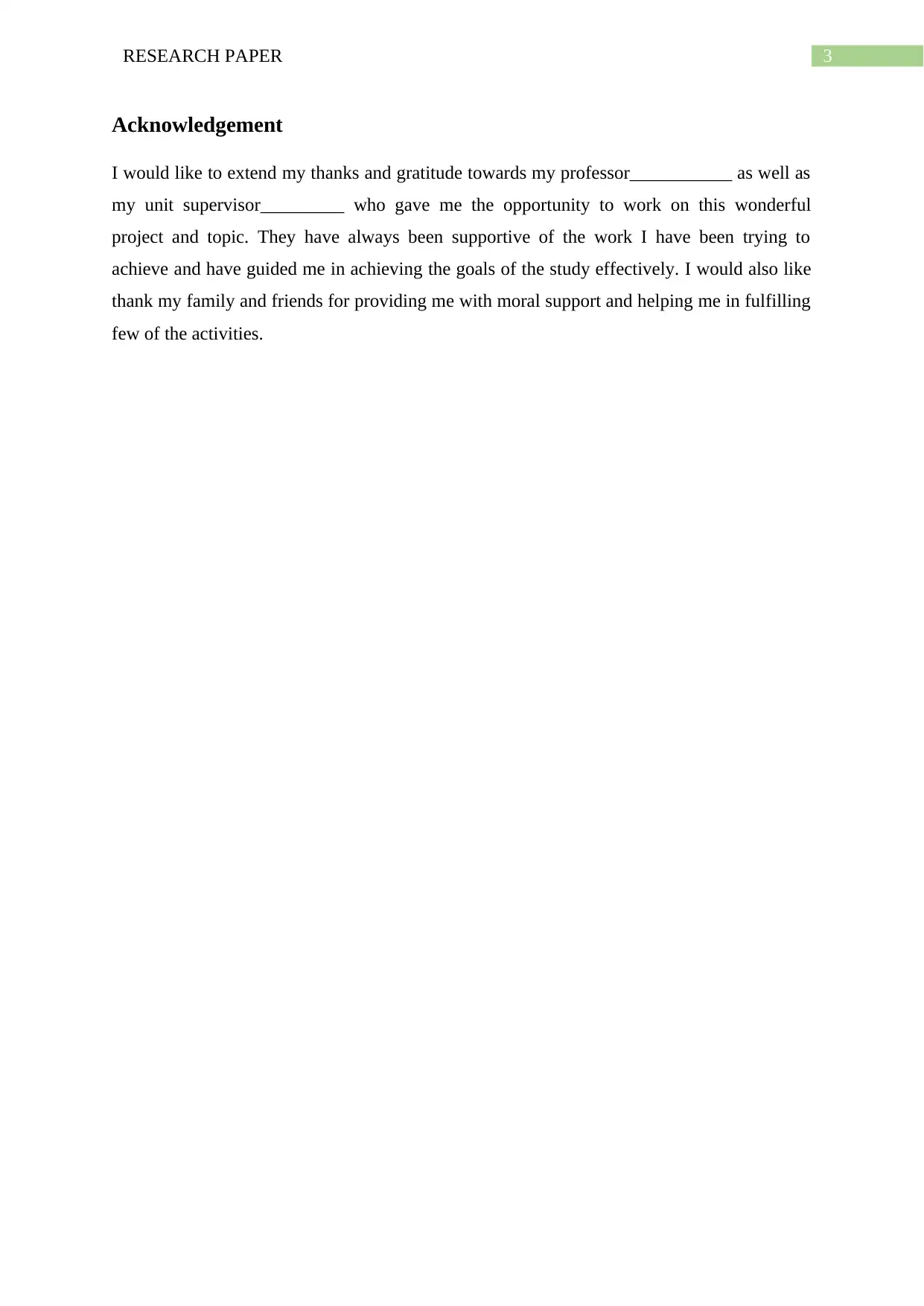
3RESEARCH PAPER
Acknowledgement
I would like to extend my thanks and gratitude towards my professor___________ as well as
my unit supervisor_________ who gave me the opportunity to work on this wonderful
project and topic. They have always been supportive of the work I have been trying to
achieve and have guided me in achieving the goals of the study effectively. I would also like
thank my family and friends for providing me with moral support and helping me in fulfilling
few of the activities.
Acknowledgement
I would like to extend my thanks and gratitude towards my professor___________ as well as
my unit supervisor_________ who gave me the opportunity to work on this wonderful
project and topic. They have always been supportive of the work I have been trying to
achieve and have guided me in achieving the goals of the study effectively. I would also like
thank my family and friends for providing me with moral support and helping me in fulfilling
few of the activities.
Paraphrase This Document
Need a fresh take? Get an instant paraphrase of this document with our AI Paraphraser
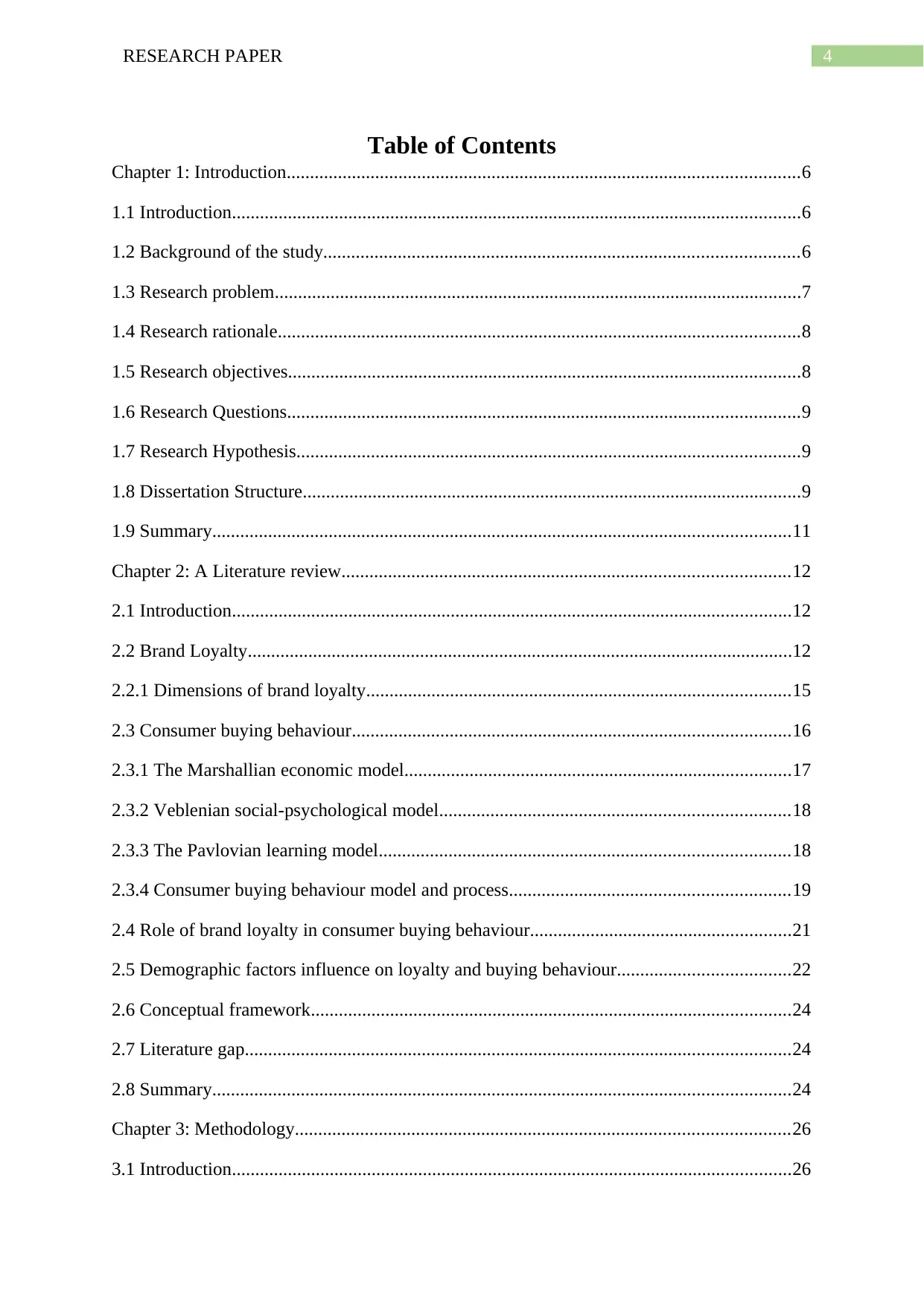
4RESEARCH PAPER
Table of Contents
Chapter 1: Introduction..............................................................................................................6
1.1 Introduction..........................................................................................................................6
1.2 Background of the study......................................................................................................6
1.3 Research problem.................................................................................................................7
1.4 Research rationale................................................................................................................8
1.5 Research objectives..............................................................................................................8
1.6 Research Questions..............................................................................................................9
1.7 Research Hypothesis............................................................................................................9
1.8 Dissertation Structure...........................................................................................................9
1.9 Summary............................................................................................................................11
Chapter 2: A Literature review................................................................................................12
2.1 Introduction........................................................................................................................12
2.2 Brand Loyalty.....................................................................................................................12
2.2.1 Dimensions of brand loyalty...........................................................................................15
2.3 Consumer buying behaviour..............................................................................................16
2.3.1 The Marshallian economic model...................................................................................17
2.3.2 Veblenian social-psychological model...........................................................................18
2.3.3 The Pavlovian learning model........................................................................................18
2.3.4 Consumer buying behaviour model and process............................................................19
2.4 Role of brand loyalty in consumer buying behaviour........................................................21
2.5 Demographic factors influence on loyalty and buying behaviour.....................................22
2.6 Conceptual framework.......................................................................................................24
2.7 Literature gap.....................................................................................................................24
2.8 Summary............................................................................................................................24
Chapter 3: Methodology..........................................................................................................26
3.1 Introduction........................................................................................................................26
Table of Contents
Chapter 1: Introduction..............................................................................................................6
1.1 Introduction..........................................................................................................................6
1.2 Background of the study......................................................................................................6
1.3 Research problem.................................................................................................................7
1.4 Research rationale................................................................................................................8
1.5 Research objectives..............................................................................................................8
1.6 Research Questions..............................................................................................................9
1.7 Research Hypothesis............................................................................................................9
1.8 Dissertation Structure...........................................................................................................9
1.9 Summary............................................................................................................................11
Chapter 2: A Literature review................................................................................................12
2.1 Introduction........................................................................................................................12
2.2 Brand Loyalty.....................................................................................................................12
2.2.1 Dimensions of brand loyalty...........................................................................................15
2.3 Consumer buying behaviour..............................................................................................16
2.3.1 The Marshallian economic model...................................................................................17
2.3.2 Veblenian social-psychological model...........................................................................18
2.3.3 The Pavlovian learning model........................................................................................18
2.3.4 Consumer buying behaviour model and process............................................................19
2.4 Role of brand loyalty in consumer buying behaviour........................................................21
2.5 Demographic factors influence on loyalty and buying behaviour.....................................22
2.6 Conceptual framework.......................................................................................................24
2.7 Literature gap.....................................................................................................................24
2.8 Summary............................................................................................................................24
Chapter 3: Methodology..........................................................................................................26
3.1 Introduction........................................................................................................................26
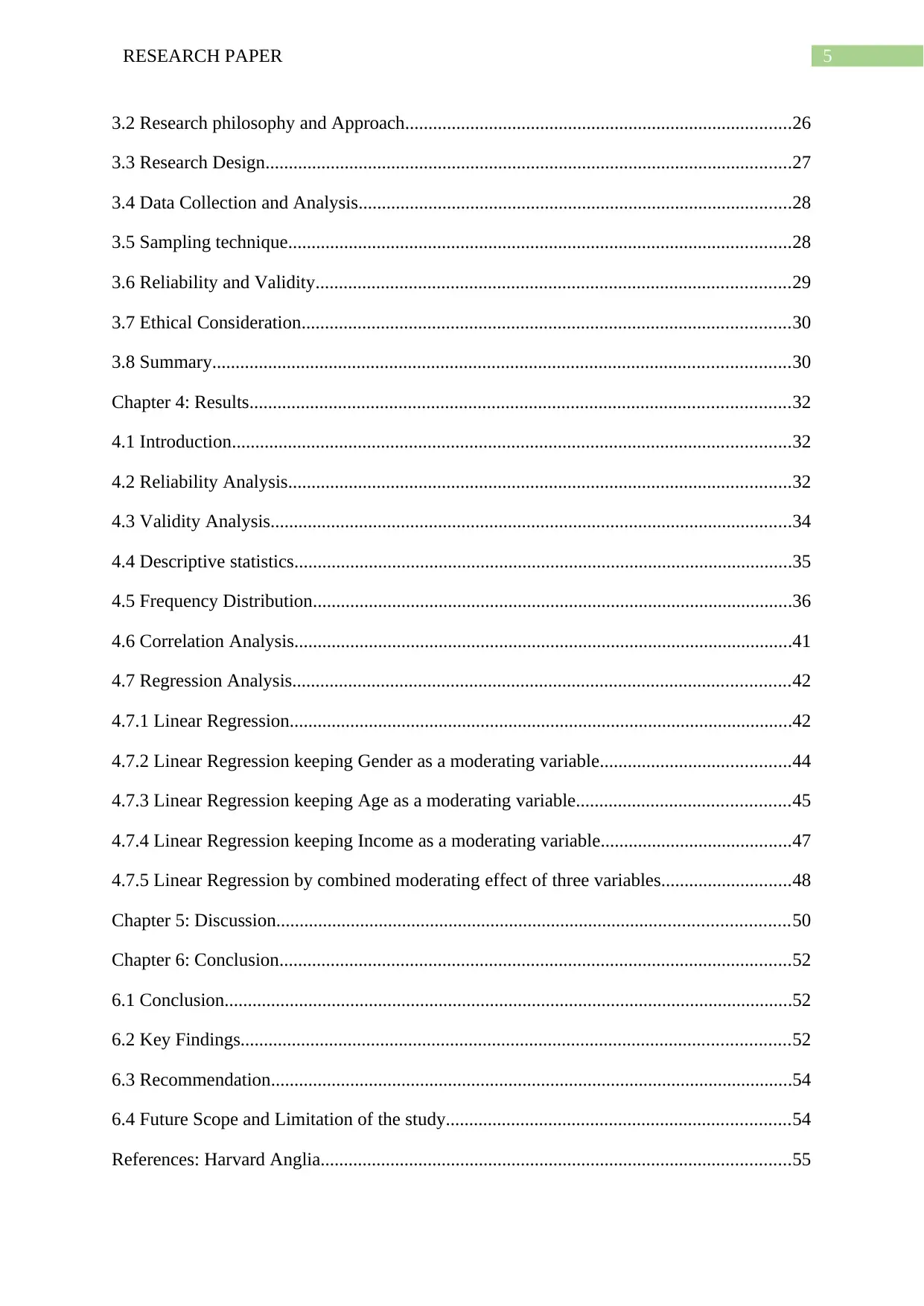
5RESEARCH PAPER
3.2 Research philosophy and Approach...................................................................................26
3.3 Research Design.................................................................................................................27
3.4 Data Collection and Analysis.............................................................................................28
3.5 Sampling technique............................................................................................................28
3.6 Reliability and Validity......................................................................................................29
3.7 Ethical Consideration.........................................................................................................30
3.8 Summary............................................................................................................................30
Chapter 4: Results....................................................................................................................32
4.1 Introduction........................................................................................................................32
4.2 Reliability Analysis............................................................................................................32
4.3 Validity Analysis................................................................................................................34
4.4 Descriptive statistics...........................................................................................................35
4.5 Frequency Distribution.......................................................................................................36
4.6 Correlation Analysis...........................................................................................................41
4.7 Regression Analysis...........................................................................................................42
4.7.1 Linear Regression............................................................................................................42
4.7.2 Linear Regression keeping Gender as a moderating variable.........................................44
4.7.3 Linear Regression keeping Age as a moderating variable..............................................45
4.7.4 Linear Regression keeping Income as a moderating variable.........................................47
4.7.5 Linear Regression by combined moderating effect of three variables............................48
Chapter 5: Discussion..............................................................................................................50
Chapter 6: Conclusion..............................................................................................................52
6.1 Conclusion..........................................................................................................................52
6.2 Key Findings......................................................................................................................52
6.3 Recommendation................................................................................................................54
6.4 Future Scope and Limitation of the study..........................................................................54
References: Harvard Anglia.....................................................................................................55
3.2 Research philosophy and Approach...................................................................................26
3.3 Research Design.................................................................................................................27
3.4 Data Collection and Analysis.............................................................................................28
3.5 Sampling technique............................................................................................................28
3.6 Reliability and Validity......................................................................................................29
3.7 Ethical Consideration.........................................................................................................30
3.8 Summary............................................................................................................................30
Chapter 4: Results....................................................................................................................32
4.1 Introduction........................................................................................................................32
4.2 Reliability Analysis............................................................................................................32
4.3 Validity Analysis................................................................................................................34
4.4 Descriptive statistics...........................................................................................................35
4.5 Frequency Distribution.......................................................................................................36
4.6 Correlation Analysis...........................................................................................................41
4.7 Regression Analysis...........................................................................................................42
4.7.1 Linear Regression............................................................................................................42
4.7.2 Linear Regression keeping Gender as a moderating variable.........................................44
4.7.3 Linear Regression keeping Age as a moderating variable..............................................45
4.7.4 Linear Regression keeping Income as a moderating variable.........................................47
4.7.5 Linear Regression by combined moderating effect of three variables............................48
Chapter 5: Discussion..............................................................................................................50
Chapter 6: Conclusion..............................................................................................................52
6.1 Conclusion..........................................................................................................................52
6.2 Key Findings......................................................................................................................52
6.3 Recommendation................................................................................................................54
6.4 Future Scope and Limitation of the study..........................................................................54
References: Harvard Anglia.....................................................................................................55
⊘ This is a preview!⊘
Do you want full access?
Subscribe today to unlock all pages.

Trusted by 1+ million students worldwide
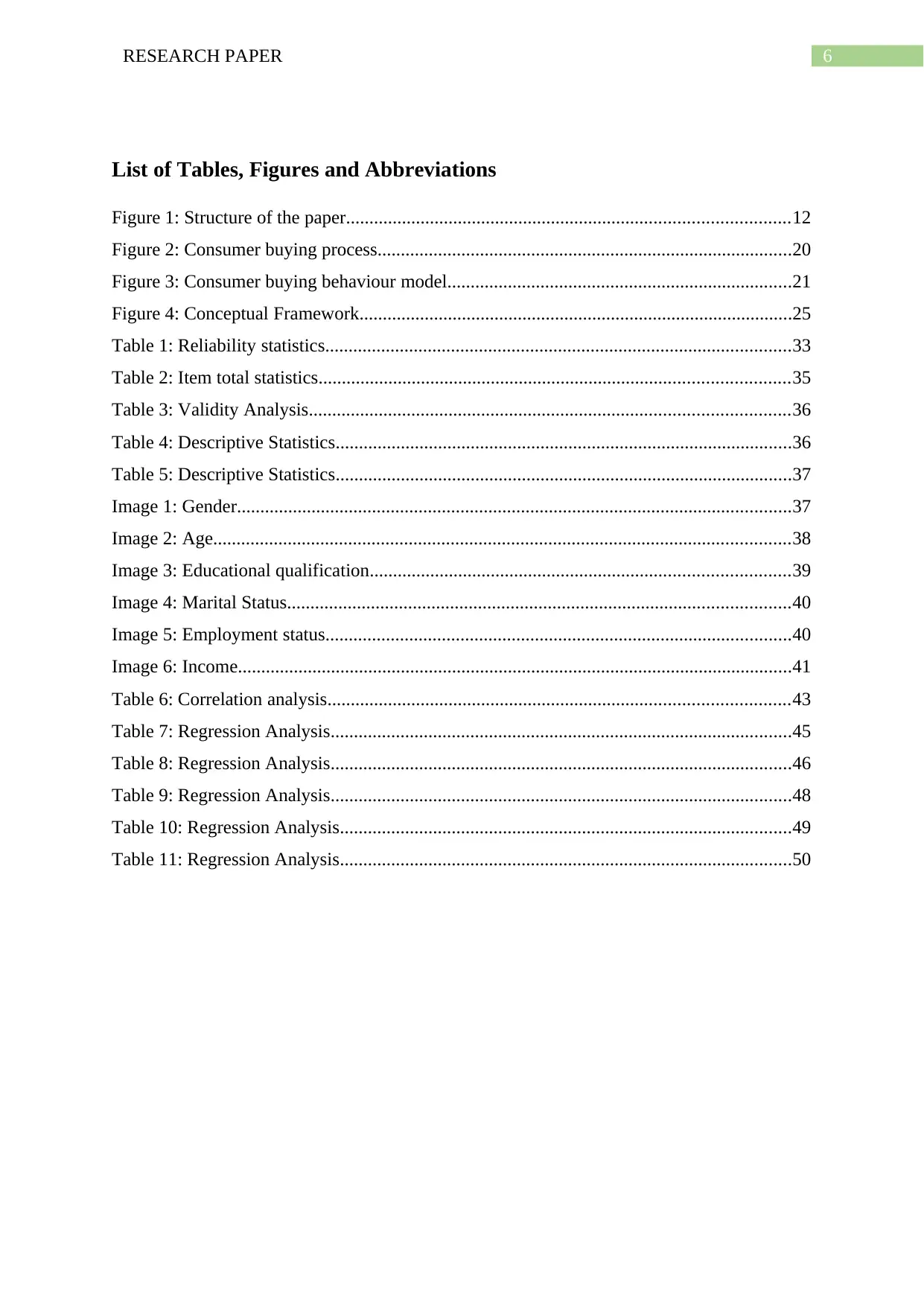
6RESEARCH PAPER
List of Tables, Figures and Abbreviations
Figure 1: Structure of the paper...............................................................................................12
Figure 2: Consumer buying process.........................................................................................20
Figure 3: Consumer buying behaviour model..........................................................................21
Figure 4: Conceptual Framework.............................................................................................25
Table 1: Reliability statistics....................................................................................................33
Table 2: Item total statistics.....................................................................................................35
Table 3: Validity Analysis.......................................................................................................36
Table 4: Descriptive Statistics..................................................................................................36
Table 5: Descriptive Statistics..................................................................................................37
Image 1: Gender.......................................................................................................................37
Image 2: Age............................................................................................................................38
Image 3: Educational qualification..........................................................................................39
Image 4: Marital Status............................................................................................................40
Image 5: Employment status....................................................................................................40
Image 6: Income.......................................................................................................................41
Table 6: Correlation analysis...................................................................................................43
Table 7: Regression Analysis...................................................................................................45
Table 8: Regression Analysis...................................................................................................46
Table 9: Regression Analysis...................................................................................................48
Table 10: Regression Analysis.................................................................................................49
Table 11: Regression Analysis.................................................................................................50
List of Tables, Figures and Abbreviations
Figure 1: Structure of the paper...............................................................................................12
Figure 2: Consumer buying process.........................................................................................20
Figure 3: Consumer buying behaviour model..........................................................................21
Figure 4: Conceptual Framework.............................................................................................25
Table 1: Reliability statistics....................................................................................................33
Table 2: Item total statistics.....................................................................................................35
Table 3: Validity Analysis.......................................................................................................36
Table 4: Descriptive Statistics..................................................................................................36
Table 5: Descriptive Statistics..................................................................................................37
Image 1: Gender.......................................................................................................................37
Image 2: Age............................................................................................................................38
Image 3: Educational qualification..........................................................................................39
Image 4: Marital Status............................................................................................................40
Image 5: Employment status....................................................................................................40
Image 6: Income.......................................................................................................................41
Table 6: Correlation analysis...................................................................................................43
Table 7: Regression Analysis...................................................................................................45
Table 8: Regression Analysis...................................................................................................46
Table 9: Regression Analysis...................................................................................................48
Table 10: Regression Analysis.................................................................................................49
Table 11: Regression Analysis.................................................................................................50
Paraphrase This Document
Need a fresh take? Get an instant paraphrase of this document with our AI Paraphraser
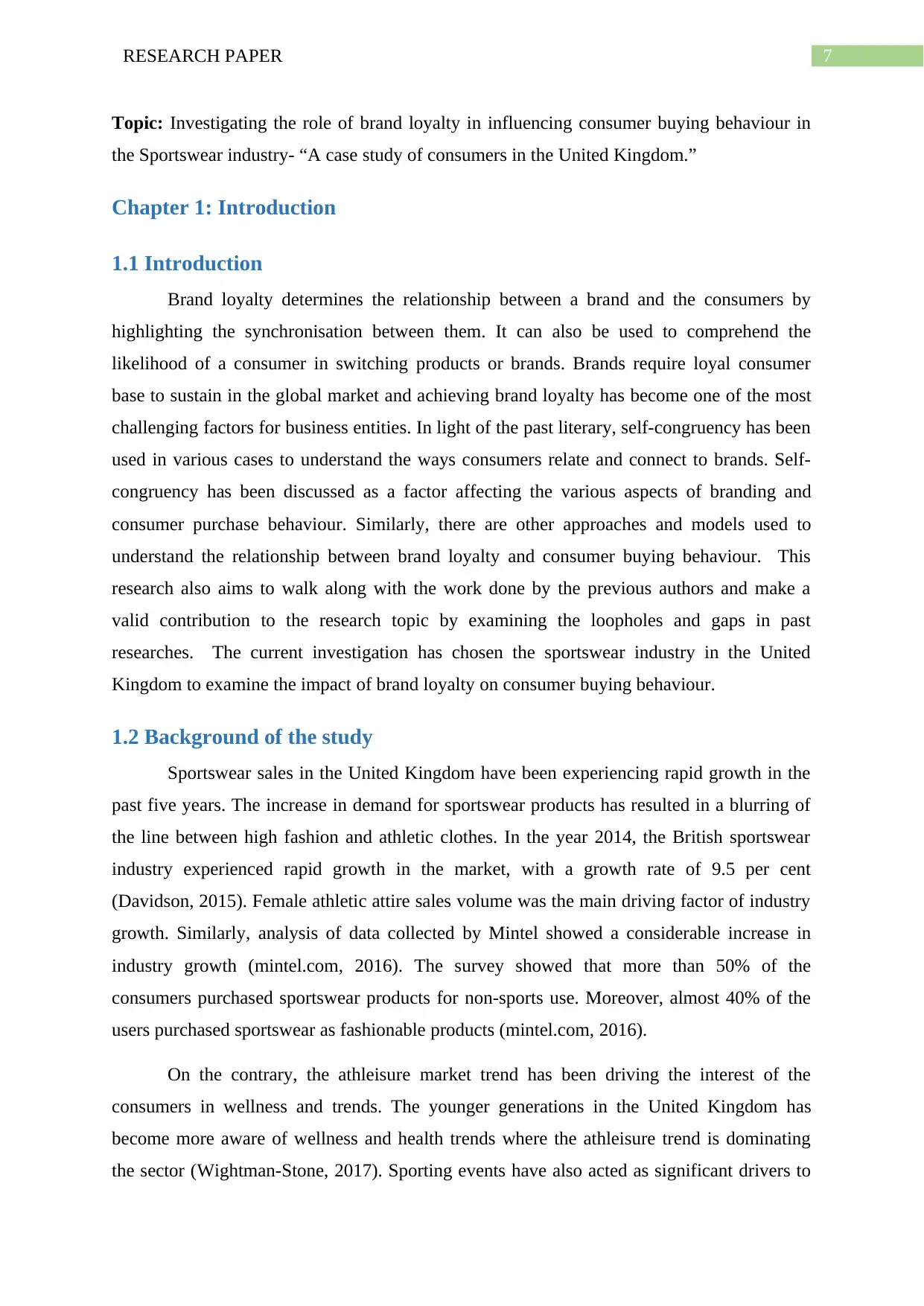
7RESEARCH PAPER
Topic: Investigating the role of brand loyalty in influencing consumer buying behaviour in
the Sportswear industry- “A case study of consumers in the United Kingdom.”
Chapter 1: Introduction
1.1 Introduction
Brand loyalty determines the relationship between a brand and the consumers by
highlighting the synchronisation between them. It can also be used to comprehend the
likelihood of a consumer in switching products or brands. Brands require loyal consumer
base to sustain in the global market and achieving brand loyalty has become one of the most
challenging factors for business entities. In light of the past literary, self-congruency has been
used in various cases to understand the ways consumers relate and connect to brands. Self-
congruency has been discussed as a factor affecting the various aspects of branding and
consumer purchase behaviour. Similarly, there are other approaches and models used to
understand the relationship between brand loyalty and consumer buying behaviour. This
research also aims to walk along with the work done by the previous authors and make a
valid contribution to the research topic by examining the loopholes and gaps in past
researches. The current investigation has chosen the sportswear industry in the United
Kingdom to examine the impact of brand loyalty on consumer buying behaviour.
1.2 Background of the study
Sportswear sales in the United Kingdom have been experiencing rapid growth in the
past five years. The increase in demand for sportswear products has resulted in a blurring of
the line between high fashion and athletic clothes. In the year 2014, the British sportswear
industry experienced rapid growth in the market, with a growth rate of 9.5 per cent
(Davidson, 2015). Female athletic attire sales volume was the main driving factor of industry
growth. Similarly, analysis of data collected by Mintel showed a considerable increase in
industry growth (mintel.com, 2016). The survey showed that more than 50% of the
consumers purchased sportswear products for non-sports use. Moreover, almost 40% of the
users purchased sportswear as fashionable products (mintel.com, 2016).
On the contrary, the athleisure market trend has been driving the interest of the
consumers in wellness and trends. The younger generations in the United Kingdom has
become more aware of wellness and health trends where the athleisure trend is dominating
the sector (Wightman-Stone, 2017). Sporting events have also acted as significant drivers to
Topic: Investigating the role of brand loyalty in influencing consumer buying behaviour in
the Sportswear industry- “A case study of consumers in the United Kingdom.”
Chapter 1: Introduction
1.1 Introduction
Brand loyalty determines the relationship between a brand and the consumers by
highlighting the synchronisation between them. It can also be used to comprehend the
likelihood of a consumer in switching products or brands. Brands require loyal consumer
base to sustain in the global market and achieving brand loyalty has become one of the most
challenging factors for business entities. In light of the past literary, self-congruency has been
used in various cases to understand the ways consumers relate and connect to brands. Self-
congruency has been discussed as a factor affecting the various aspects of branding and
consumer purchase behaviour. Similarly, there are other approaches and models used to
understand the relationship between brand loyalty and consumer buying behaviour. This
research also aims to walk along with the work done by the previous authors and make a
valid contribution to the research topic by examining the loopholes and gaps in past
researches. The current investigation has chosen the sportswear industry in the United
Kingdom to examine the impact of brand loyalty on consumer buying behaviour.
1.2 Background of the study
Sportswear sales in the United Kingdom have been experiencing rapid growth in the
past five years. The increase in demand for sportswear products has resulted in a blurring of
the line between high fashion and athletic clothes. In the year 2014, the British sportswear
industry experienced rapid growth in the market, with a growth rate of 9.5 per cent
(Davidson, 2015). Female athletic attire sales volume was the main driving factor of industry
growth. Similarly, analysis of data collected by Mintel showed a considerable increase in
industry growth (mintel.com, 2016). The survey showed that more than 50% of the
consumers purchased sportswear products for non-sports use. Moreover, almost 40% of the
users purchased sportswear as fashionable products (mintel.com, 2016).
On the contrary, the athleisure market trend has been driving the interest of the
consumers in wellness and trends. The younger generations in the United Kingdom has
become more aware of wellness and health trends where the athleisure trend is dominating
the sector (Wightman-Stone, 2017). Sporting events have also acted as significant drivers to
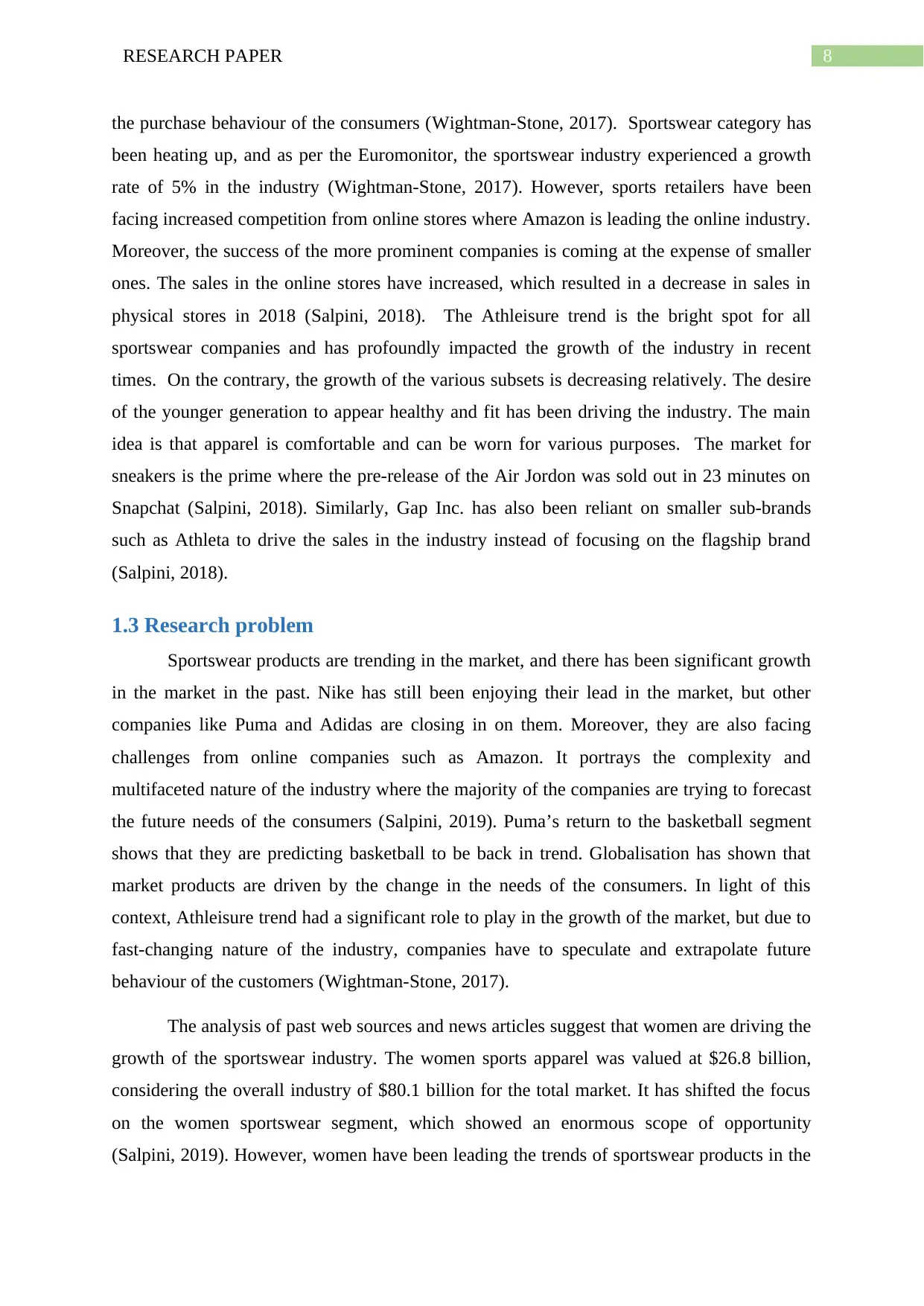
8RESEARCH PAPER
the purchase behaviour of the consumers (Wightman-Stone, 2017). Sportswear category has
been heating up, and as per the Euromonitor, the sportswear industry experienced a growth
rate of 5% in the industry (Wightman-Stone, 2017). However, sports retailers have been
facing increased competition from online stores where Amazon is leading the online industry.
Moreover, the success of the more prominent companies is coming at the expense of smaller
ones. The sales in the online stores have increased, which resulted in a decrease in sales in
physical stores in 2018 (Salpini, 2018). The Athleisure trend is the bright spot for all
sportswear companies and has profoundly impacted the growth of the industry in recent
times. On the contrary, the growth of the various subsets is decreasing relatively. The desire
of the younger generation to appear healthy and fit has been driving the industry. The main
idea is that apparel is comfortable and can be worn for various purposes. The market for
sneakers is the prime where the pre-release of the Air Jordon was sold out in 23 minutes on
Snapchat (Salpini, 2018). Similarly, Gap Inc. has also been reliant on smaller sub-brands
such as Athleta to drive the sales in the industry instead of focusing on the flagship brand
(Salpini, 2018).
1.3 Research problem
Sportswear products are trending in the market, and there has been significant growth
in the market in the past. Nike has still been enjoying their lead in the market, but other
companies like Puma and Adidas are closing in on them. Moreover, they are also facing
challenges from online companies such as Amazon. It portrays the complexity and
multifaceted nature of the industry where the majority of the companies are trying to forecast
the future needs of the consumers (Salpini, 2019). Puma’s return to the basketball segment
shows that they are predicting basketball to be back in trend. Globalisation has shown that
market products are driven by the change in the needs of the consumers. In light of this
context, Athleisure trend had a significant role to play in the growth of the market, but due to
fast-changing nature of the industry, companies have to speculate and extrapolate future
behaviour of the customers (Wightman-Stone, 2017).
The analysis of past web sources and news articles suggest that women are driving the
growth of the sportswear industry. The women sports apparel was valued at $26.8 billion,
considering the overall industry of $80.1 billion for the total market. It has shifted the focus
on the women sportswear segment, which showed an enormous scope of opportunity
(Salpini, 2019). However, women have been leading the trends of sportswear products in the
the purchase behaviour of the consumers (Wightman-Stone, 2017). Sportswear category has
been heating up, and as per the Euromonitor, the sportswear industry experienced a growth
rate of 5% in the industry (Wightman-Stone, 2017). However, sports retailers have been
facing increased competition from online stores where Amazon is leading the online industry.
Moreover, the success of the more prominent companies is coming at the expense of smaller
ones. The sales in the online stores have increased, which resulted in a decrease in sales in
physical stores in 2018 (Salpini, 2018). The Athleisure trend is the bright spot for all
sportswear companies and has profoundly impacted the growth of the industry in recent
times. On the contrary, the growth of the various subsets is decreasing relatively. The desire
of the younger generation to appear healthy and fit has been driving the industry. The main
idea is that apparel is comfortable and can be worn for various purposes. The market for
sneakers is the prime where the pre-release of the Air Jordon was sold out in 23 minutes on
Snapchat (Salpini, 2018). Similarly, Gap Inc. has also been reliant on smaller sub-brands
such as Athleta to drive the sales in the industry instead of focusing on the flagship brand
(Salpini, 2018).
1.3 Research problem
Sportswear products are trending in the market, and there has been significant growth
in the market in the past. Nike has still been enjoying their lead in the market, but other
companies like Puma and Adidas are closing in on them. Moreover, they are also facing
challenges from online companies such as Amazon. It portrays the complexity and
multifaceted nature of the industry where the majority of the companies are trying to forecast
the future needs of the consumers (Salpini, 2019). Puma’s return to the basketball segment
shows that they are predicting basketball to be back in trend. Globalisation has shown that
market products are driven by the change in the needs of the consumers. In light of this
context, Athleisure trend had a significant role to play in the growth of the market, but due to
fast-changing nature of the industry, companies have to speculate and extrapolate future
behaviour of the customers (Wightman-Stone, 2017).
The analysis of past web sources and news articles suggest that women are driving the
growth of the sportswear industry. The women sports apparel was valued at $26.8 billion,
considering the overall industry of $80.1 billion for the total market. It has shifted the focus
on the women sportswear segment, which showed an enormous scope of opportunity
(Salpini, 2019). However, women have been leading the trends of sportswear products in the
⊘ This is a preview!⊘
Do you want full access?
Subscribe today to unlock all pages.

Trusted by 1+ million students worldwide
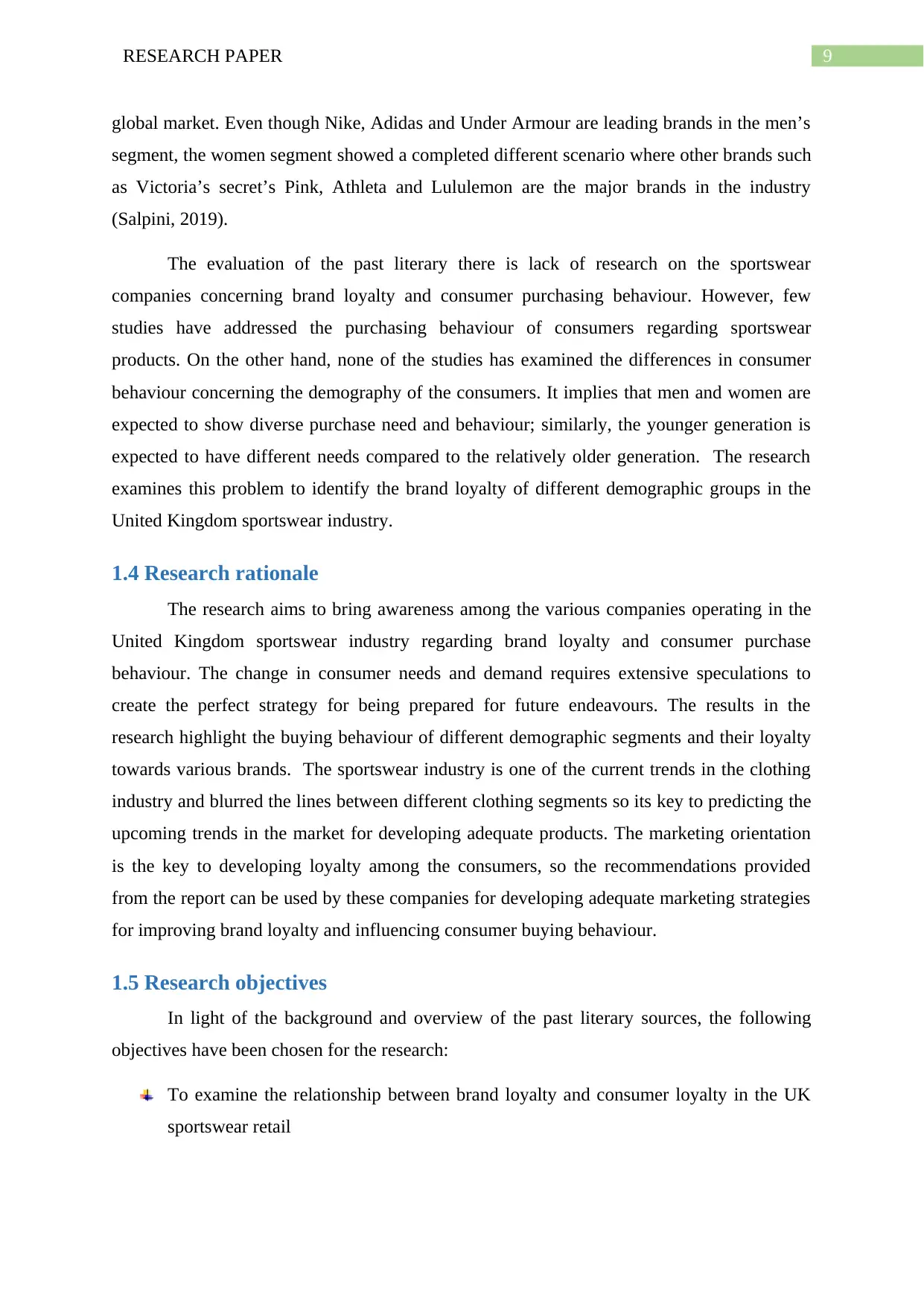
9RESEARCH PAPER
global market. Even though Nike, Adidas and Under Armour are leading brands in the men’s
segment, the women segment showed a completed different scenario where other brands such
as Victoria’s secret’s Pink, Athleta and Lululemon are the major brands in the industry
(Salpini, 2019).
The evaluation of the past literary there is lack of research on the sportswear
companies concerning brand loyalty and consumer purchasing behaviour. However, few
studies have addressed the purchasing behaviour of consumers regarding sportswear
products. On the other hand, none of the studies has examined the differences in consumer
behaviour concerning the demography of the consumers. It implies that men and women are
expected to show diverse purchase need and behaviour; similarly, the younger generation is
expected to have different needs compared to the relatively older generation. The research
examines this problem to identify the brand loyalty of different demographic groups in the
United Kingdom sportswear industry.
1.4 Research rationale
The research aims to bring awareness among the various companies operating in the
United Kingdom sportswear industry regarding brand loyalty and consumer purchase
behaviour. The change in consumer needs and demand requires extensive speculations to
create the perfect strategy for being prepared for future endeavours. The results in the
research highlight the buying behaviour of different demographic segments and their loyalty
towards various brands. The sportswear industry is one of the current trends in the clothing
industry and blurred the lines between different clothing segments so its key to predicting the
upcoming trends in the market for developing adequate products. The marketing orientation
is the key to developing loyalty among the consumers, so the recommendations provided
from the report can be used by these companies for developing adequate marketing strategies
for improving brand loyalty and influencing consumer buying behaviour.
1.5 Research objectives
In light of the background and overview of the past literary sources, the following
objectives have been chosen for the research:
To examine the relationship between brand loyalty and consumer loyalty in the UK
sportswear retail
global market. Even though Nike, Adidas and Under Armour are leading brands in the men’s
segment, the women segment showed a completed different scenario where other brands such
as Victoria’s secret’s Pink, Athleta and Lululemon are the major brands in the industry
(Salpini, 2019).
The evaluation of the past literary there is lack of research on the sportswear
companies concerning brand loyalty and consumer purchasing behaviour. However, few
studies have addressed the purchasing behaviour of consumers regarding sportswear
products. On the other hand, none of the studies has examined the differences in consumer
behaviour concerning the demography of the consumers. It implies that men and women are
expected to show diverse purchase need and behaviour; similarly, the younger generation is
expected to have different needs compared to the relatively older generation. The research
examines this problem to identify the brand loyalty of different demographic groups in the
United Kingdom sportswear industry.
1.4 Research rationale
The research aims to bring awareness among the various companies operating in the
United Kingdom sportswear industry regarding brand loyalty and consumer purchase
behaviour. The change in consumer needs and demand requires extensive speculations to
create the perfect strategy for being prepared for future endeavours. The results in the
research highlight the buying behaviour of different demographic segments and their loyalty
towards various brands. The sportswear industry is one of the current trends in the clothing
industry and blurred the lines between different clothing segments so its key to predicting the
upcoming trends in the market for developing adequate products. The marketing orientation
is the key to developing loyalty among the consumers, so the recommendations provided
from the report can be used by these companies for developing adequate marketing strategies
for improving brand loyalty and influencing consumer buying behaviour.
1.5 Research objectives
In light of the background and overview of the past literary sources, the following
objectives have been chosen for the research:
To examine the relationship between brand loyalty and consumer loyalty in the UK
sportswear retail
Paraphrase This Document
Need a fresh take? Get an instant paraphrase of this document with our AI Paraphraser
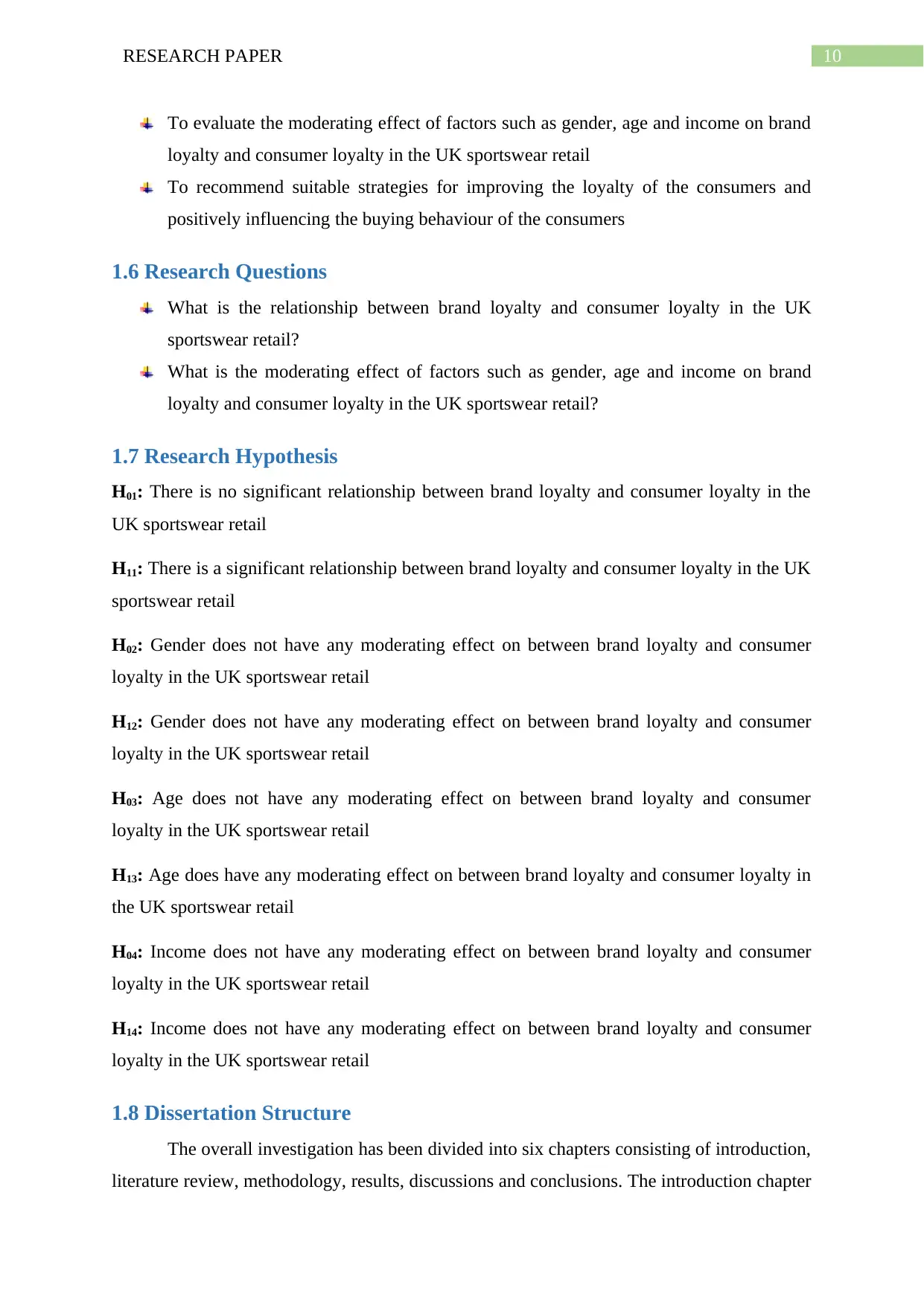
10RESEARCH PAPER
To evaluate the moderating effect of factors such as gender, age and income on brand
loyalty and consumer loyalty in the UK sportswear retail
To recommend suitable strategies for improving the loyalty of the consumers and
positively influencing the buying behaviour of the consumers
1.6 Research Questions
What is the relationship between brand loyalty and consumer loyalty in the UK
sportswear retail?
What is the moderating effect of factors such as gender, age and income on brand
loyalty and consumer loyalty in the UK sportswear retail?
1.7 Research Hypothesis
H01: There is no significant relationship between brand loyalty and consumer loyalty in the
UK sportswear retail
H11: There is a significant relationship between brand loyalty and consumer loyalty in the UK
sportswear retail
H02: Gender does not have any moderating effect on between brand loyalty and consumer
loyalty in the UK sportswear retail
H12: Gender does not have any moderating effect on between brand loyalty and consumer
loyalty in the UK sportswear retail
H03: Age does not have any moderating effect on between brand loyalty and consumer
loyalty in the UK sportswear retail
H13: Age does have any moderating effect on between brand loyalty and consumer loyalty in
the UK sportswear retail
H04: Income does not have any moderating effect on between brand loyalty and consumer
loyalty in the UK sportswear retail
H14: Income does not have any moderating effect on between brand loyalty and consumer
loyalty in the UK sportswear retail
1.8 Dissertation Structure
The overall investigation has been divided into six chapters consisting of introduction,
literature review, methodology, results, discussions and conclusions. The introduction chapter
To evaluate the moderating effect of factors such as gender, age and income on brand
loyalty and consumer loyalty in the UK sportswear retail
To recommend suitable strategies for improving the loyalty of the consumers and
positively influencing the buying behaviour of the consumers
1.6 Research Questions
What is the relationship between brand loyalty and consumer loyalty in the UK
sportswear retail?
What is the moderating effect of factors such as gender, age and income on brand
loyalty and consumer loyalty in the UK sportswear retail?
1.7 Research Hypothesis
H01: There is no significant relationship between brand loyalty and consumer loyalty in the
UK sportswear retail
H11: There is a significant relationship between brand loyalty and consumer loyalty in the UK
sportswear retail
H02: Gender does not have any moderating effect on between brand loyalty and consumer
loyalty in the UK sportswear retail
H12: Gender does not have any moderating effect on between brand loyalty and consumer
loyalty in the UK sportswear retail
H03: Age does not have any moderating effect on between brand loyalty and consumer
loyalty in the UK sportswear retail
H13: Age does have any moderating effect on between brand loyalty and consumer loyalty in
the UK sportswear retail
H04: Income does not have any moderating effect on between brand loyalty and consumer
loyalty in the UK sportswear retail
H14: Income does not have any moderating effect on between brand loyalty and consumer
loyalty in the UK sportswear retail
1.8 Dissertation Structure
The overall investigation has been divided into six chapters consisting of introduction,
literature review, methodology, results, discussions and conclusions. The introduction chapter
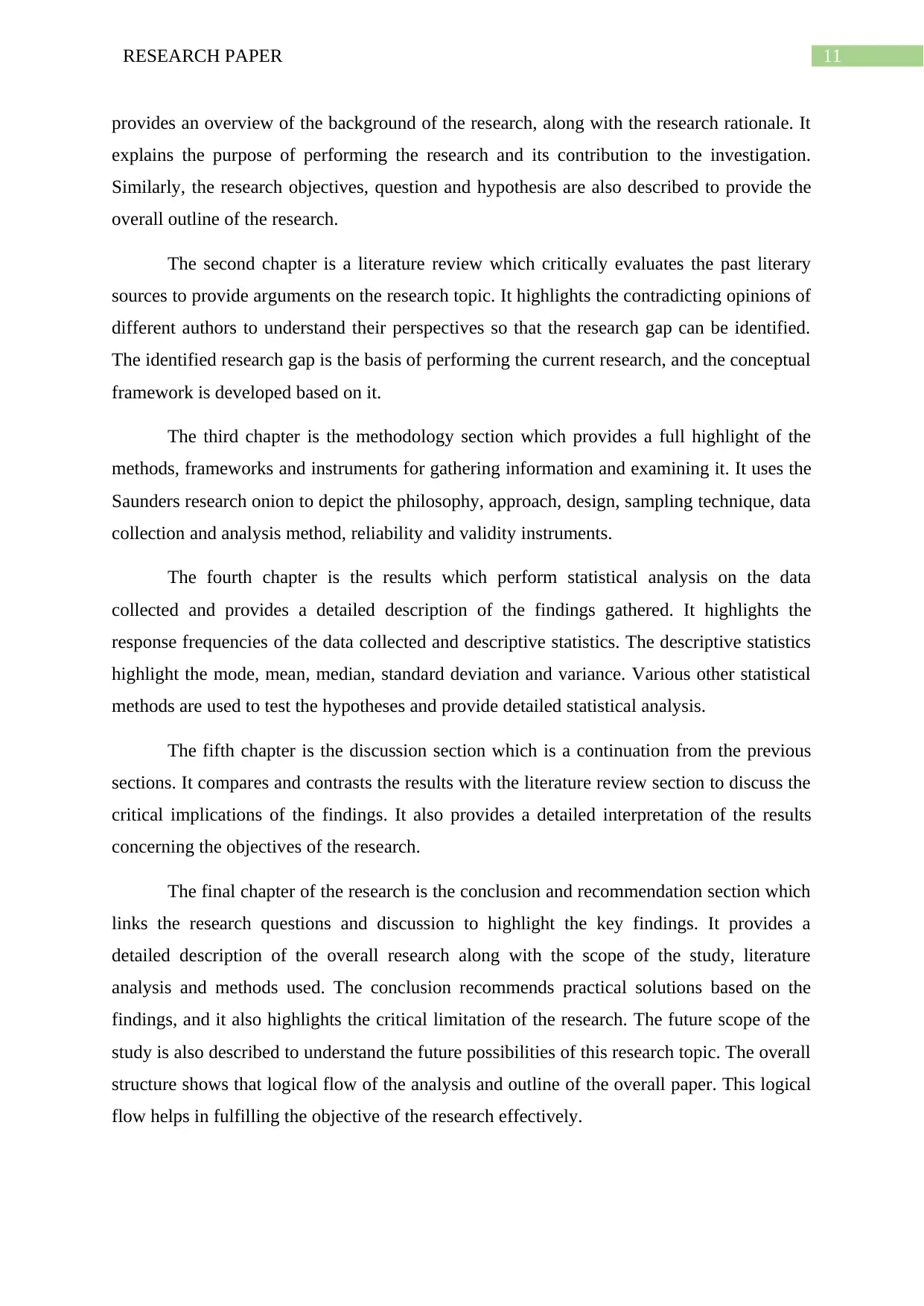
11RESEARCH PAPER
provides an overview of the background of the research, along with the research rationale. It
explains the purpose of performing the research and its contribution to the investigation.
Similarly, the research objectives, question and hypothesis are also described to provide the
overall outline of the research.
The second chapter is a literature review which critically evaluates the past literary
sources to provide arguments on the research topic. It highlights the contradicting opinions of
different authors to understand their perspectives so that the research gap can be identified.
The identified research gap is the basis of performing the current research, and the conceptual
framework is developed based on it.
The third chapter is the methodology section which provides a full highlight of the
methods, frameworks and instruments for gathering information and examining it. It uses the
Saunders research onion to depict the philosophy, approach, design, sampling technique, data
collection and analysis method, reliability and validity instruments.
The fourth chapter is the results which perform statistical analysis on the data
collected and provides a detailed description of the findings gathered. It highlights the
response frequencies of the data collected and descriptive statistics. The descriptive statistics
highlight the mode, mean, median, standard deviation and variance. Various other statistical
methods are used to test the hypotheses and provide detailed statistical analysis.
The fifth chapter is the discussion section which is a continuation from the previous
sections. It compares and contrasts the results with the literature review section to discuss the
critical implications of the findings. It also provides a detailed interpretation of the results
concerning the objectives of the research.
The final chapter of the research is the conclusion and recommendation section which
links the research questions and discussion to highlight the key findings. It provides a
detailed description of the overall research along with the scope of the study, literature
analysis and methods used. The conclusion recommends practical solutions based on the
findings, and it also highlights the critical limitation of the research. The future scope of the
study is also described to understand the future possibilities of this research topic. The overall
structure shows that logical flow of the analysis and outline of the overall paper. This logical
flow helps in fulfilling the objective of the research effectively.
provides an overview of the background of the research, along with the research rationale. It
explains the purpose of performing the research and its contribution to the investigation.
Similarly, the research objectives, question and hypothesis are also described to provide the
overall outline of the research.
The second chapter is a literature review which critically evaluates the past literary
sources to provide arguments on the research topic. It highlights the contradicting opinions of
different authors to understand their perspectives so that the research gap can be identified.
The identified research gap is the basis of performing the current research, and the conceptual
framework is developed based on it.
The third chapter is the methodology section which provides a full highlight of the
methods, frameworks and instruments for gathering information and examining it. It uses the
Saunders research onion to depict the philosophy, approach, design, sampling technique, data
collection and analysis method, reliability and validity instruments.
The fourth chapter is the results which perform statistical analysis on the data
collected and provides a detailed description of the findings gathered. It highlights the
response frequencies of the data collected and descriptive statistics. The descriptive statistics
highlight the mode, mean, median, standard deviation and variance. Various other statistical
methods are used to test the hypotheses and provide detailed statistical analysis.
The fifth chapter is the discussion section which is a continuation from the previous
sections. It compares and contrasts the results with the literature review section to discuss the
critical implications of the findings. It also provides a detailed interpretation of the results
concerning the objectives of the research.
The final chapter of the research is the conclusion and recommendation section which
links the research questions and discussion to highlight the key findings. It provides a
detailed description of the overall research along with the scope of the study, literature
analysis and methods used. The conclusion recommends practical solutions based on the
findings, and it also highlights the critical limitation of the research. The future scope of the
study is also described to understand the future possibilities of this research topic. The overall
structure shows that logical flow of the analysis and outline of the overall paper. This logical
flow helps in fulfilling the objective of the research effectively.
⊘ This is a preview!⊘
Do you want full access?
Subscribe today to unlock all pages.

Trusted by 1+ million students worldwide
1 out of 68
Related Documents
Your All-in-One AI-Powered Toolkit for Academic Success.
+13062052269
info@desklib.com
Available 24*7 on WhatsApp / Email
![[object Object]](/_next/static/media/star-bottom.7253800d.svg)
Unlock your academic potential
Copyright © 2020–2025 A2Z Services. All Rights Reserved. Developed and managed by ZUCOL.





